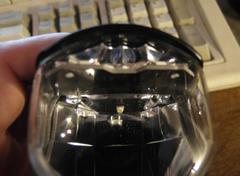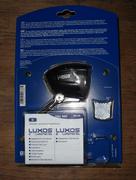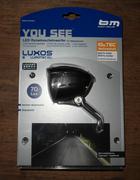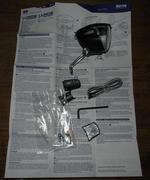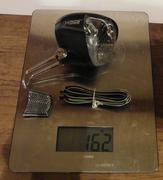Busch & Mueller: Luxos B & Luxos U dynamo headlamps
Introduction
On the main page I wrote:
B&M Luxos: I've ordered a Luxos-B and Luxos-U which should arrive sometime from mid December to early January. I'm curious about its performance and especially the more expensive U variant has some good features. But I suspect it will disappoint in the beam shape/intensity... For example I see some irregularities in the beam in B&M's beamshots which will probably turn out far worse in reallity, considering my experiences with the Cyo RT. Further, if B&M really want to improve on existing headlamps, they will need to work around StVZO in one of the ways I described. Whether they do that (can do that) is to be seen. If not then the headlamp will probably disappoint in some way. Note that a lux value has no value in itself in deciding how good a lamp is, and the light output of LEDs has only increased a little. So it should give a bit more light in total which would most usefully be used by giving a broader beam shape than the current Cyo, Edelux, Philips Saferide 60 (because using the light to give a more intense beam is less effective because of the logarithmic nature of the human eye, i.e. a lot higher intensity is needed to experience it as brighter). It should also have a even light distribution which is a weak point of many headlamps, and whether it's clearly better than such headlamps (which it must be considering the price B&M asks for it, though for the U variant with USB output this point would be moot), is doubtful. But we will see...
Review
Tested: Luxos B: From 19 Dec. 2012.
Experiences
2012-12-19 evening: First ride with the Luxos B on road 1 shows the cutoff is very sharp, as it should be when using a LED that doesn't have a huge emitting surface (Cree XT-E?) and quite a large reflector. In the middle is a strong hotspot, or perhaps hotcone, which is distracting. The evenness of the beam (on the road) is still nowhere near the quality of the Philips LED bike light/Saferide 80 battery lamp. The intensity of the beam outside that hotspot is a bit too low. The beam is pretty wide and nicely lights up the road I tried it on including the green on the left/right, though at not enough intensity compared to the hotspot. The daylight lights are again of the variety 'visibility by being annoying to all other road users', that B&M seems to like. Not even a diffuser by making the lens slightly less transparant at the top where the 4 daylight LEDs are located, though the light is being reflected and this is better than direct light from the LEDs... The light colour of those DRL LEDs is thankfully white and not blue/purple as with the awful Cyo RT that I tested. I can only see about 40-45 m with it (on the road surface), this is not better than the Saferide 60 nor Edelux.
To give a better view of how good the lamp is I will do a comparison while riding, using switchbox v2, with a few headlamps, soon.
My prediction was spot on about the unevenness in the beam, and that nothing miraculous could be expected due to the 2.4W power restriction demanded by StVZO...
2012-12-20, test ride at from 2:40-3:00 at night on road 3 comparing it with the Saferide 60 shows that the hotspot doesn't stand out as much here (I think because the road is narrower and it's less noticeable on the reddish road surface) and the weaker beam outside the main cone also doesn't stand out in being weaker as much as it did on road 1. I would say the beam is comparable to the Saferide 60, with the beam having a far stricter cutoff which is good so it will be aimed correctly too, and the beam starts very close to the front wheel which is also good. The light colour looks slightly worse (cooler) than the Saferide 60. All in all I would say, at this moment (note it's very early in the review, so my conclusion is not finished yet) is that for the extra money, the Luxos B doesn't add anything really worthwile over a Saferide 60.
I made a video comparing the Luxos B and Saferide 60, starting with the Saferide 60, then the 2nd half with the Luxos B. When viewing this video you need to take into account that the Saferide 60 was mounted at ca. 1.00m, the Luxos at 0.75m. This means the intensity in the near field of the Saferide 60 is dimmer than if it was mounted at 0.75m, and the gap between bike and light beam is also bigger than if the Saferide 60 were mounted at 0.75m, see the main lighting page for more on this effect of changing beam shape/intensity related to mounting height. But a proper comparison with both lamps mounted at the same height and switching while riding will come soon. It was also very windy, so lots of noise in the video. And finally the lamps were both not yet optimally angled, but it was just a quick video to show both lamps.
Video: 2012-12-20--Samsung_EX1--Philips_Saferide_60_vs_BM_Luxos_B (32 MB)
Stills from the video (1: Start, 2: Philips Saferide 60 with mounting height of ca. 1.00m, 3: Luxos B):
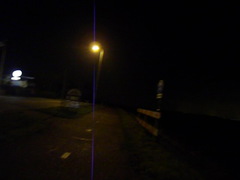
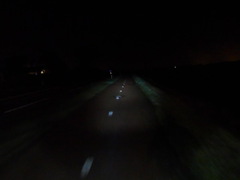
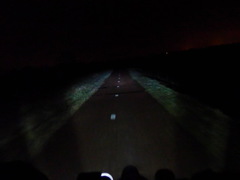
The video seems fairly dark, so when playing the video set the brightness such that it's brighter than the stills so and that you can clearly see the reddish sky on the righ, and you will get some idea of the real illumination (for someone with normal night vision).
The hotspot is quite noticeable in the video, more so than I experienced it when riding. Also the Luxos looks to have a far wider illumination which I don't experience when riding, I felt on this short ride at least, that the lamps are not that different, but it certainly shows that the luxos puts a lot of light in making the beam wide. This difference between camera view and experience is caused by limitations in cameras (dynamic range) compared to the human eye...
Because of its very strict cutoff you can angle the headlamp such that you will not blind oncoming traffic and still light up fences on the side of the road at 70m or more. This is quite good, also for curves. Note that the road surface is not illuminated any better than the Saferide 60. You can only properly see the road surface for about 40-45 m with it. This shows that a lot of improvement is still possible in dynamo lighting (when going around StVZO's 2.4W power requirement), as with the Philips-LBL+dynamo driver I have a stronger and more even beam that lights up the road at least 70m, with even more light than the original battery version (about 330 lumen vs. 270 lumen).
At this point I feel the biggest issue with the Luxos is the strong hotspot. I will be riding a lot more with it the coming time, so more experiences to come.
2012-12-24, night: Flickering at low speed (5-7 km/h) when starting a ride is significant, much more so than with the Saferide 60. On road 2, so a wider road with ditches next to it and farmers' fields beside it. I tested the Luxos against the Saferide 60 again and my conclusions haven't changed. The beam is wider at large distance but there it gets pretty weak and thus not useful enough. At short distance the beam looks wider than the Saferide 60's beam, but due to the fact that the intensity of the Saferide's beam drops off more gracefuly instead of sharply, and that it doesn't have a hot spot/section to which your eyes will adjust, the Saferide 60 is in actual use, even though it will probably look worse on beamshots (yet to be made), just as good. The hot section is perhaps 1.5 m wide, starts at ca. 12 m and ends at ca. 25 m. I also rode from a little hill, thought 'Wow, the Luxos lights up everything up to long distance', so to verify I rode back, switched to the Saferide 60, and it did exactly the same thing. Comparing beam shape, the Saferide 60's beam is more even, more pleasant. Finally on another road with fairly good asphalt which was partially wet I compared the way you can identify the road surface and wet spots (see also my page on experiments with LEDs about this issue, as wet spots look like some types of asphalt-repairs when using cool white light) and the Saferide 60 was better. This was to be expected though the Saferide 60 still has a far too cool light colour.
2012-12-25, night: Test on a meandering piece of road showed that the Luxos B is barely better than the Saferide 60. Especially the fact that the beam of the Luxos B is only wide at distances of ca. 20m or more, means that you still feel you're going blind into bends. I made a video that I will upload. The Luxos U has more near-field light apparantly, as per B&M's beamshot on their website which doesn't correspond to the Luxos B in the near field, so it must be the U version.
4-1-2012: Ride in the rain, comparing the H-one S to the Luxos B and a torch that I modified with a neutral white XP-G LED (colour 5B1, not yet optimal, something like 4C is better):
I started with the H-one S and the first section of the beam, that I think is of too high intensity compared to the rest of the beam, stands out very well in the rain, it does not disappear. If only the rest of the beam could be made this bright the lamp would be fantastic. I then switched to the Luxos B and there was a big problem with it: The near field in case of rain is very much overexposed because you see almost nothing from the rest of the beam and thus you only see the light close which will remain better to see because of the angles, which makes the problem worse. [ Btw., in my own reflector design in December I chose light to start at 3 m from the lamp, and at reduced intensity there compared to ca. 15m and further... ] So in the rain the neutral white colour of the H-one S kicked ass, and the artefacts and overexposure of the Luxos-B close to the bike are very annoying such that you see very little with it. Especially problematic with glasses and raindrops on it, I felt I was almost blinded by the Luxos B. Comparing the H-one S with the torch: The torch is clearly better in the garden at close range, at larger distance the difference becomes less, but there is some difference such as the grass with water on it looks whiter with the H-one S than with the torch.
Stainless steel torx bolts rusting:
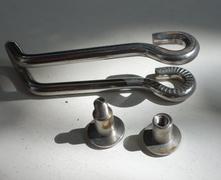
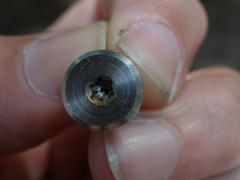
Stainless steel can rust, how much depends on the added ingredients... Here the 2 parts of the bolt are of different types of stainless steel (which you can verify by holding a magnet to them) and one rusts fairly quickly. Nothing exceptional, no galvanic corrosion from another metal, well, the bolts of course do touch the mounting bracket which is stainless steel too.
Luxos B and Luxos U in standard mode beamshots using Sony RX100, F2.0 2s ISO200:


The beamshots are just about identical, just the high mode to make, the lamp switches to low mode after a stop which was the reason my high mode beamshot didn't work. I will remake that soon.
Conclusion, Luxos B
Luxos B: Strong hot section from ca. 12-25 m which makes the rest of the beam look darker than it really is (because your eyes adjust to the hotspot). Cutoff is very strict which is good at larger distance so you will aim the lamp correctly for oncoming traffic, and with it you can light up fences without blinding other cyclists (very hard with the Saferide 60), but the cutoff is also strict to a weaker part of the beam beam close to the rider (see the beam shot) which is not so good. Light colour is too cool, inferior to the Saferide 60. Beam shape is not better than the Saferide 60 which is more pleasant due to being more even and the beam colour is slightly better. It has auto on/off and for people who want daytime lights, it has those too. On winding roads it's not really better than the Saferide 60. This means that my original view hasn't changed, and that though the Luxos B looks better on video/beamshots, due to the way the eye works it's not really better. So whether this lamp is worth the extra money over a Saferide 60 depends on how you value the daytime lights and the auto on/off.
Experiences in the rain have not yet been taken into account in the above, which just make the case for the Saferide 60 stronger. Note that the Saferide 60 overexposes the near field as well, just not as badly as the Luxos...
Luxos U
Tested: Luxos U: From ca. 15 June 2013.
Luxos U: My guess was that its value is probably mainly in the USB power output. This makes it worth buying even if the beam shape is not really better than that of the Saferide 60 (yet to be determined of course, as the U has panorama near field light and a 90 lux high mode). Early models had lots of problems so B&M delayed further distribution and a revised model was finally made available since early April 2013.
17-6-2013: The Luxos U has a handlebar mounted switch/USB output. It also has a high mode and it's supposed to have 'panoramic' light but I didn't notice that yet. The higher power mode is made possible using the internal battery. The handlebar mounted switch has a blue LED that lights up insanely bright and from a point source, shining into my eye when pointing the switch such that the USB connector is on the left. Perhaps when placing the switch/USB output in the other direction, the direct light from the LED will be obscured by one's finger, but I'd have to check.
22-6-2013: Further rides the past few days I checked lots of things, beamshape is not as in the B&M picture, it's still the same as in the beamshot from the video of the B version, when I put the U in high mode, and in high mode it's supposed to put the LEDs for panoramic mode on as well. I notice the light on the road getting brighter, but no additional light close to the bike on other spots, so the beam pattern and how clearly you see the segments of it (and/or artefacts) stays the same. I also didn't notice as on my first test on an unlit road on 17-6-2013, that the blue LED is too bright. Not sure why not, perhaps the LED's light is in a very tight bundle, and I had aimed it just so that shone into my eye? I will check. Or perhaps some fault in the light causing the LED to shine up too brightly that time? There's a second LED, a red one, in the handlebar switch which indicates whether the internal batter is fully charged, which turns on then. I would think green is a more logical choice especially as these LEDs are not located on the body of the light where there are 2 LEDs to indicate taillamp working (green) and the lamp status (yellow), so there's no possiblity to confuse them. Then panoramic light: You're supposed to be able to set the speed at which this kicks in, and then it gets brighter when you go slower. I set it to about 15 km/h just in case this was set incorrectly at the factory, using the method mentioned in the leaflet (keeping the handlebar button pressed for a bit more than 10 seconds during which time the light goes o/off 5 times). For some reason the panoramic light just doesn't seem to work on my lamp. Perhaps at very very slow speed it does something, as sometimes I got a jump in lightoutput when going very slowly, but 6km/h, the limit at which the panoramic light is supposed to be the strongest, is a speed at which I normally stop riding... So it could have been effects from starting/stopping riding? I will check on later rides. I checked the effect of what should happen in panoramic mode by switching to high mode (as panoramic should also be on then) and looking at the light and its pattern close to the bike. The pattern didn't change but it got brighter. I will check whether the panoramic LEDs really do something, to check that they are lighting I mean, soon. At the moment it looks like B&M's beamshot just doesn't represent reality at all (their tunnel shots are pretty poor in any event because they hide unevenness in the beam, as I have said long ago already in another review). Regarding the panoramic light my view is this: The Luxos puts out way too much light close to the bike at all times, you don't need more 'panoramic' light.
23-6-2013: My bike which was parked on the grass, fell over from the strong wind. A gentle fall, absorbed largely by the rear panniers too, and yet after this, the light went on-off-on-etc. all the time and it couldn't be switched off. When I disconnected the handlebar switch/USB power output the lamp worked properly. So either the lamp or switch/USB is defective. I have opened up the headlamp and saw nothing pointing to any damage or obvious fault. This situation further made me think about the plug for the handlebar switch/USB output: 3.5 mm plugs are not very sturdy and the female plug on the lamp means the lamp is essentially open there, ready for water to come in in case the bike falls over and the cable gets pulled out (didn't happen in my case, but it's possible if your bike is parked near say bushes). Perhaps water can even enter while the 3.5 mm male plug is still inserted. Much better would have been a solution as used by Sheng-li in their Bank-light...
25-6-2013: I tried a switch/USB from a second Luxos U, and then the headlamp worked fine. So the switch/USB is defective. Perhaps some water got into it the days before? I had left the bike outside in the rain as I always do to test my equipment. I will dry out the switch to see if it fixed the situation but if that fixes it then the switch is not waterproof... And I suppose the fall only made the water get to a place where it caused some slight short circuit.
26-6-2013: I put the switch close to my teapot to make it warm so as to evaporate any water that might be inside the switch. After a short while there was a tiny bit of condensation on the rubbery see-through cover of the actual on/off switch, so there was some water in it... I kept it there for a few hours. At that time there was no sign of condensation any more and I connected it to the lamp. It worked! So this means I won't have to send the lamp back, or not yet anyway. The switch is definitely not waterproof enough. I don't know what to do about this, disassemble the switch and make it better than wat B&M made, encase the innards in silicone for example, or send back to the distributor as being defective, if this happens again?
Further issues in the rain: When I replaced the handlebar switch, it was raining a little and some moisture got on the plug it seems. The headlamp started switching on-of-on-off etc. again. So I left it out, and when it got dry I plugged it in again. This shows that if you take out the plug or it is pulled out when it rains, you can't just plug it back in. The headlamp is way too sensitive to small leak currents from water on the plug. And of course using a 3.5mm plug is a bad idea anyway.
When making the beamshots, I took off the switch to unscrew the lamp from the bike, and put it on the grass. Big mistake! It was slightly damp, and putting the connector back into the lamp gave the same issue again with the lamp flashing on-off all the time.
The LED light colour is cool white and comparing it to my neutral white modifed torch while riding showed how poor the colour spectrum of the Luxos is. The stronger the beam, the more clear the superiority of neutral white LEDs becomes, so the Luxos which puts out a lot of light, should have had a neutral white LED.
Luxos B and Luxos U in standard mode beamshots using Sony RX100, F2.0 2s ISO200:


The beamshots are just about identical, just the high mode to make, the lamp switches to low mode after a stop which was the reason my high mode beamshot didn't work. I will remake that soon.
USB charging
22-7-2013: Nighttime ride of 22km: I used my Galaxy Y phone with Osmand navigation for a ride, with the Luxos U charging the phone while also having the headlamp on. This worked nicely, the phone's charge went up, with the screen at the lowest brightness setting.
22-7-2013: Daytime 7 km ride: Tab2-7 charged about 3% (big error margin possible of course) on a ride of ca. 7 km at about 20km/h. This seems similar to the Luxx70 plus' charging power. After a while (ca. 5 km) the Tab2 repeatedly beeps to indicate charging starts. Why? I've not stopped... This is problematic as the screen goes on when charging starts, wasting power in the Tab. There's an application for such issues caused by dynamo or solar powered chargers, but why is this happening? I got a report on charging being fast when the battery is full, then stopping and starting again until there's some charge in the battery. That could be it, except that my red battery indicator lamp was always on... What's going on? I guess I need to make longer rides.
Some more tests show that the Luxos U charges my phone a bit faster than the Luxx70 plus, but this could be due to the buffer (Li-ion battery) which was full before all USB output tests. I haven't tested the difference on longer trips than 10 km.
While a USB device is attached (or at least draws power) the lamp doesn't switch into high mode (well, just briefly), but instead powers USB.
Conclusion, Luxos U
My original guess of the value of the Luxos U was right, the USB output is what this lamp is worth buying for, not the beamshape. I will do some side by side tests switching between headlamps to compare with the Saferide 60 and then I will give my verdict on precisely how the Luxos fares, but for the conclusion it doesn't matter:
The beamshape considering the size of the reflector is extremely disappointing (well, let's just say it: poor) in all aspects except the sharpness of the cutoff. The unevenness in the beamshape is annoying, the lamp has a bad beam pattern because of the horrendous overexposure of the near field and strong artefacts in the beam. In the rain this issue is even bigger. The beam is no match at all for the reflector in the Philips LBL/Saferide 80 which was introduced in 2009 already... Yes, that's a battery powered lamp but it can be run with even more power from dynamo as I've shown on my site.
The handlebar mounted switch uses a very bad type of connector (3.5mm) to the headlamp, the electronics in the lamp is way too sensitve to small leak currents which becomes clear when the 3.5mm plug is wet or even just damp, and the handlebar switch is not waterproof in some samples, which is caused by the top being made of 2 parts of different materials. The switch also has zero tactile feedback which means you will tend to press the button too hard, it might cause early cracking of the PCB or demise of the switch. This whole switch design looks bad to me. The panorama light doesn't work well (perhaps if you accelerate like a snail you will notice it, I only noticed a jump in light ouptut near the speed where I stop, ca. 6 km/h), and it's not needed because the Luxos already overexposes the near field.
The LED light colour is poor, cool white. Why? B&M should know by now that this is a bad choice.
The competition to the Luxos U are the Saferide 60 and Luxx70 plus. But they are also not competition because the Saferide 60 has no USB power output, the Luxx70 plus doesn't have USB power output when the light is on. So these are different lamps that you must choose depending on your requirements. Regarding the beam, in both beamshape and beam strength the Saferide 60 is most pleasant and the Luxos is not better even though it's brighter. The Luxx70plus sits in the middle. If you don't need USB power output at night, and don't want to spend a lot of money, then get the Luxx70 plus. But the beam of the Saferide 60 is better. So if you don't need USB power putput, get the Saferide 60.
Last modified: Mon Oct 14 05:20:25 CEST 2013
